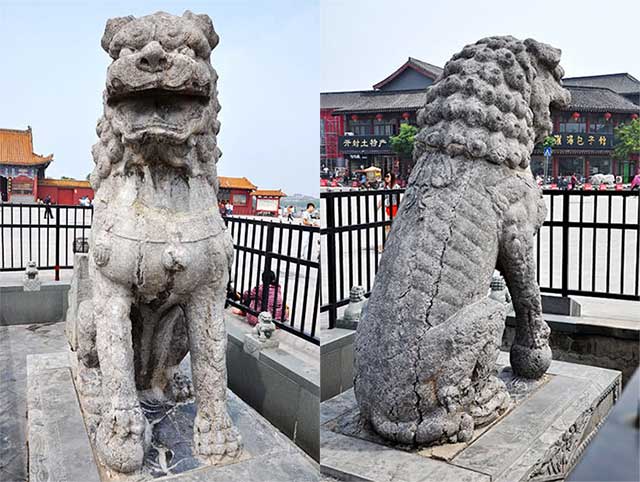Controversy about the origin of the beast statue Khai Phong from ancient times
Kaifeng, also known in China as 'Bian', was formerly known as Bianzhou (Bianzhou) or Bian Luong (Bianliang). It is a provincial city in Henan province and is one of the central cities in the core area of the Center for Urban Plains and Cultural Tourism of China.
Although Kaifeng was an ancient capital of the Chinese imperial court, the ruins that were left in the city were few. The main reason is that too many floods from the Yellow River destroyed the ruins of ancient civilization. There are Long Dinh , considered a famous scenic spot in the city of Kaifeng left, is considered the remains of the royal palace of six dynasties including the Northern Song Dynasty.
In front of Long Dinh gate, a pair of stone lions stood upright , with a height of over 3 meters, their feet stepped on a hydrangea flower, their eyes were wide open and their mouth wide open, becoming a witness to the prosperous dynasties thousands of years ago. . There are many historical records about the pair of stone lions, showing that the people of Khai Phong have a small affection for this pair of beastly statues. However, an interesting fact is that so far, the exact origin of the stone lion pair has not yet been determined.

This pair of stone lions is also known as the Lion Stone Lion.
According to the research, this pair of stone lions was moved to the Gate of the Ngo Dynasty in the Qing Dynasty, so it is also known as the Stone Gate Lion. Up to now, the vast majority of people have speculated that the pair of lions are from the Northern Song period, and are the gatekeepers in front of the Song court. However, no one has yet confirmed this is the truth.
Due to the lack of accurate historical data, archaeologists could not rely on technology to obtain information. They can only rely on the analysis of stone carvings. In a historical record, the pair of stone lions was placed in front of the gate of King Minh Chu. Therefore, this meticulously carved stone pair cannot be later than the Ming Dynasty.
Looking closely, even though the idol statue is currently in a state of severe damage, it is still possible to see the carving technique is not trivial. Create a simple image but emit majestic atmosphere, full details but not too complicated decoration, the image of lion cubs and hydrangeas is also very simple. This style of stone carvings is clearly different from the style of stone lions in the north and south during the Ming and Qing dynasties, most likely reminiscent of the Tang Dynasty.

The stone lion carvings set as gate-keeping deities came from the Tang Dynasty.
Judging from the history of the dynasties, the Song Dynasty was a turning point in the feudal dynasties of China, and the style of stone lion carvings also fits the shape of the existing twin beasts in Kaifeng.
In fact, the stone lion carvings made as gate-keeping gods originated from the Tang dynasty, then maintained until the Song and Yuan dynasties. The primitive and strong stone lion initially changed shape to a more sophisticated and sophisticated style. The back of this pair of lions is also shaped to protrude the ribs. In other words, this is a pair of skinny lions. This detail is different from the style of the Song Dynasty. It is also different from the lion guarding the tomb of the Northern Song period, which archaeologists have studied in Gongyi City in Henan Province. Moreover, although the carvings are not trivial, if you say this is the lion of the palace, there is still a big gap.
By the Yuan Dynasty, a provincial management system was applied. At that time, Kaifeng was the headquarters in Jiangbei, Henan. Therefore, there are also speculations that this pair of beasts are likely to come from the Yuan Dynasty.
It can be said that, although there is still a lot of controversy surrounding the origin of this pair of stone lions, but no one can deny that this pair of beasts has become a witness to prosperous dynasties. in Chinese history.
- Discovering the statue of Apollo in Gaza
- The project revives wonders of the ancient world
- Mysterious rooster statue in ancient Roman tomb
- Discovering the mystery in the ground of ancient My Son tower
- Found 1,900 year old eagle statue between London
- Compare 7 world wonders in ancient and modern times
- The statue of ancient Kali is unearthed from the riverbed
- Detecting debris from a 40-thousand-year-old mammoth ivory statue
- Detecting an ancient jars in Phong Nha cave
- Digging soil to detect a 1000 year old god statue
- Discovered an ancient Buddha image of 2000 years of rare and rare blush
- Egypt announced two giant pharaohs
 The truth about the mysterious red-haired giant at Lovelock Cave
The truth about the mysterious red-haired giant at Lovelock Cave Inunaki Tunnel: The haunted road leading into Japan's 'village of death'
Inunaki Tunnel: The haunted road leading into Japan's 'village of death' The mystery of the phenomenon of human reflection before dying
The mystery of the phenomenon of human reflection before dying 6 mysterious phenomena, although science has been developed for a long time, still cannot be answered
6 mysterious phenomena, although science has been developed for a long time, still cannot be answered